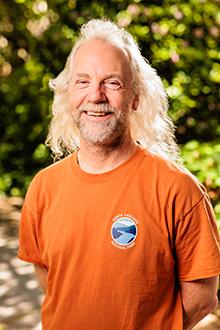
Ocean Mixing - Exploring the physics of turbulence and mixing is key to our understanding of ocean dynamics. Innovative instrumentation, detailed analysis, and simple dynamical models enable us to:
We seek motivated students at all levels to work with our team to explore the turbulent world around us.
Send me an email if you want to join us to investigate ocean-ice physics, solve climate-related challenges, develop skills to analyze data and devise creative ways to understand geophysical dynamics.
We develop and deploy instruments to explore dynamics that includes the smallest scales of motion. These are crucial to understanding ocean turbulence and its effects. Some of our projects of the Ocean Mixing Group include:
As relatively warm ocean waters interact with marine-terminating glaciers, they produce buoyant plumes of meltwaters that rise along the face of the glacier, creating beautiful colors and patterns that reveal details of the fluid dynamics that formed them. We are developing new instruments to probe the boundary-layer dynamics responsible for ice melt.
Take a look at Erin Pettit's site that describes some of our recent work in Alaska
Our team of faculty, graduate and engineering & physics undergraduate students work together we envision, build, and deploy new systems to explore fundamental physics of the natural world.
Many thanks go to Nick McCombe, June Marion, and an amazing team of OSU engineers for visioning and creating our first Robotic Oceanographic Surface Sampler (ROSS), pictured below in the Bay of Bengal, near India.
Where river waters meet the coastal ocean, buoyant plumes of fresh water collide with seawater, creating strong fronts, intense mixing, and the exchange of nutrients that fuel biological productivity.
An example of the three-dimensional structure of the upper ocean in the Gulf of Mexico as collected from our autonomous vessel, AR/V Polly, who performed this repeated triangle 30 times (at approximately 4.5-h repeat rate) during a 6-day period. The left panel shows temperature from Polly's towed T-chain, the right panel is the meridional component of velocity.
B.Sc., Queen's University at Kingston, Ont. (Engineering Physics), 1991
M.Sc., Cornell University (Environmental Engineering), 1995
Ph.D., Oregon State University (Physical Oceanography), May 2000
PhD Candidates -- Anna Simpson, Kaelan Weiss, Nadia Cohen, Fucent Hsu
Post-docs -- Ken Zhao, Aurelie Moulin
Techs -- Jasmine Nahorniak, Noah Osman
Undergrads -- Erica Tindal, Kyle Jenson, Diego Camacho, Sam Felsted and more
Collaboration is what makes science fun. At OSU, Meagan Wengrove, Erin Pettit, Eric Skyllingstad, Jesse Cusack, Astrid Leitner, Kipp Shearman, Jessica Garwood, Jim Moum, Bill Smyth work closely and in complementary ways with our group
Lots of great science happens elsewhere. We work collaboratively with Jen MacKinnon, Matthew Alford, Amy Waterhouse, Sarah Purkey, Effie Fine (at Scripps/UCSD), Trevor Harrison at UW, John Taylor at Cambridge, Leif Thomas at Stanford, Dave Sutherland at the UofO, Becca Jackson at Rutgers, Jody Klymak at University of Victoria.
Alaska Glaciers on Petersburg's KFSK
Popping bubbles make glaciers melt faster (EOS)
Link to Jonathan's Google Scholar page
Below is an assortment of recent work:
Melting of glacier ice enhanced by bursting air bubbles (2023) Nature Geoscience 16 (10), 871-876 (ME Wengrove, EC Pettit, JD Nash, RH Jackson, ED Skyllingstad)
Internal gravity waves generated by subglacial discharge: Implications for tidewater glacier melt (2022) Geophysical Research Letters, 50 (12) (JM Cusack, RH Jackson, JD Nash, E Skyllingstad, EC Pettit)
Meltwater intrusions reveal mechanisms for rapid submarine melt at a tidewater glacier (2020) Geophysical Research Letters 47 (2), (RH Jackson, JD Nash, C Kienholz, DA Sutherland, JM Amundson, ...)
Climate process team on internal wave–driven ocean mixing (2017) Bulletin of the American Meteorological Society, 2017 (JA MacKinnon, Z Zhao, CB Whalen, AF Waterhouse, JD Nash,...)
Hotspots of deep ocean mixing on the Oregon continental slope, Geophys. Res. Lett., 34, L01605, doi:10.1029/2006GL028170, 2007 (Nash, J. D., M. H. Alford, E. Kunze, K. Martini, and S. Kelly)
Structure of the baroclinic tide generated at Kaena Ridge, Hawaii, J. Phys. Oceanogr., 36(6), 1123-1135, 2006 (Nash, J.D., E. Kunze, C.M. Lee and T.B. Sanford)
River plumes as a source of large-amplitude internal waves in the coastal ocean, Nature, 437, 400-403, 2005 doi:10.1038/nature03936 (J.D. Nash and J.N. Moum)
Estimating Internal Wave Energy Fluxes in the Ocean, J. Atmos. and Oceanic Tech., 22(10), 1551-1570, 2005 (J.D. Nash, M.H. Alford and E. Kunze).
Internal tide reflection and turbulent mixing on the continental slope, J. Phys. Oceanogr. 34(5), 1117-1134, 2004 (J.D. Nash, E. Kunze, J. M. Toole and R. W. Schmitt)
Microstructure observations of turbulent salinity flux and the dissipation spectrum of salinity, J. Phys. Oceanogr., 2002, 32, 2312-2333 (J.D. Nash and J.N. Moum).
Internal hydraulic flows on the continental shelf: high drag states over a small bank, J. Geophys. Res., 106, 4593-4611, 2001 (J.D. Nash and J.N. Moum)
Estimating salinity variance dissipation rate from microstructure conductivity measurements, J. Oceanic Atmos. Technol., 16, 263-274 , 1999 (J.D. Nash and J.N. Moum)